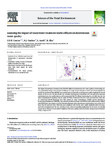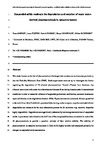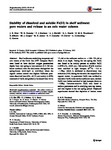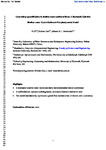Assessing the impact of wastewater treatment works effluent on downstream water quality
| dc.contributor.author | Comber, Sean | |
| dc.contributor.author | Gardner, MJ | |
| dc.contributor.author | Ansell, Lauren | |
| dc.contributor.author | Ellor, B | |
| dc.date.accessioned | 2022-07-29T09:35:37Z | |
| dc.date.issued | 2022-11-01 | |
| dc.identifier.issn | 1879-1026 | |
| dc.identifier.issn | 1879-1026 | |
| dc.identifier.other | 157284 | |
| dc.identifier.uri | http://hdl.handle.net/10026.1/19462 | |
| dc.description | Source info: STOTEN-D-22-12137 | |
| dc.description.abstract |
The impact of wastewater treatment works (WwTW) effluent on downstream river water quality is of increasing concern, particularly owing to the presence in effluents of a range of trace substances. In the case of contamination by metals the question of bioavailability has recently been accounted for in setting water quality standards for several metals. In the UK over the past decade the Chemical Investigations Programme (CIP) has generated upstream and downstream river quality data as well as associated WwTW effluent monitoring for over 600 sites, for the main contaminants of regulatory interest under the Water Framework Directive. Data presented here show that at a local level WwTW discharges have little impact for many contaminants. Soluble reactive phosphorus, hexabromocyclododecane (HBCDD), cypermethrin, perfluorooctanoic acid (PFOA) and perfluorooctane sulfonic acid (PFOS) have been shown to be the principal substances where downstream concentrations were at least 10 % larger than the upstream value. Otherwise, poor compliance with riverine water quality standards tends to be associated with contamination at the river catchment scale, with corresponding implications for the nature of remedial actions that are likely to be successful. Compliance with water quality criteria for metals, taking account of bioavailability, is high overall. | |
| dc.format.extent | 157284-157284 | |
| dc.format.medium | Print-Electronic | |
| dc.language | en | |
| dc.language.iso | eng | |
| dc.publisher | Elsevier | |
| dc.subject | Bioavailability | |
| dc.subject | Effluent | |
| dc.subject | Priority chemicals | |
| dc.subject | Trace metals | |
| dc.subject | Water quality | |
| dc.subject | Environmental Monitoring | |
| dc.subject | Rivers | |
| dc.subject | Wastewater | |
| dc.subject | Water Pollutants, Chemical | |
| dc.subject | Water Purification | |
| dc.subject | Water Quality | |
| dc.title | Assessing the impact of wastewater treatment works effluent on downstream water quality | |
| dc.type | journal-article | |
| dc.type | Journal Article | |
| plymouth.author-url | https://www.ncbi.nlm.nih.gov/pubmed/35835200 | |
| plymouth.volume | 845 | |
| plymouth.publication-status | Published | |
| plymouth.journal | Science of the Total Environment | |
| dc.identifier.doi | 10.1016/j.scitotenv.2022.157284 | |
| plymouth.organisational-group | /Plymouth | |
| plymouth.organisational-group | /Plymouth/Faculty of Science and Engineering | |
| plymouth.organisational-group | /Plymouth/Faculty of Science and Engineering/School of Engineering, Computing and Mathematics | |
| plymouth.organisational-group | /Plymouth/Faculty of Science and Engineering/School of Geography, Earth and Environmental Sciences | |
| plymouth.organisational-group | /Plymouth/REF 2021 Researchers by UoA | |
| plymouth.organisational-group | /Plymouth/REF 2021 Researchers by UoA/UoA06 Agriculture, Veterinary and Food Science | |
| plymouth.organisational-group | /Plymouth/Research Groups | |
| plymouth.organisational-group | /Plymouth/Research Groups/BEACh | |
| plymouth.organisational-group | /Plymouth/Research Groups/Marine Institute | |
| plymouth.organisational-group | /Plymouth/Users by role | |
| plymouth.organisational-group | /Plymouth/Users by role/Academics | |
| dc.publisher.place | Netherlands | |
| dcterms.dateAccepted | 2022-07-06 | |
| dc.rights.embargodate | 2022-7-30 | |
| dc.identifier.eissn | 1879-1026 | |
| dc.rights.embargoperiod | Not known | |
| rioxxterms.versionofrecord | 10.1016/j.scitotenv.2022.157284 | |
| rioxxterms.licenseref.uri | http://www.rioxx.net/licenses/all-rights-reserved | |
| rioxxterms.licenseref.startdate | 2022-07-11 | |
| rioxxterms.type | Journal Article/Review |





